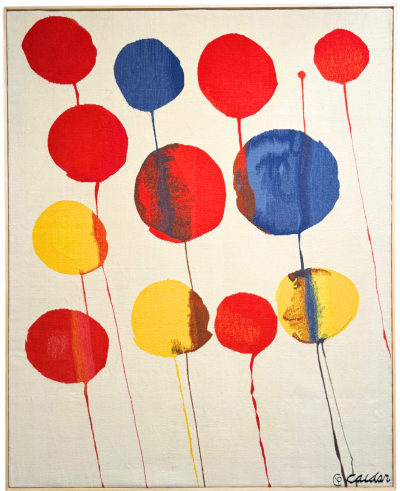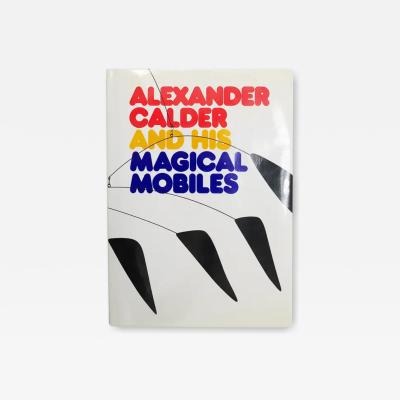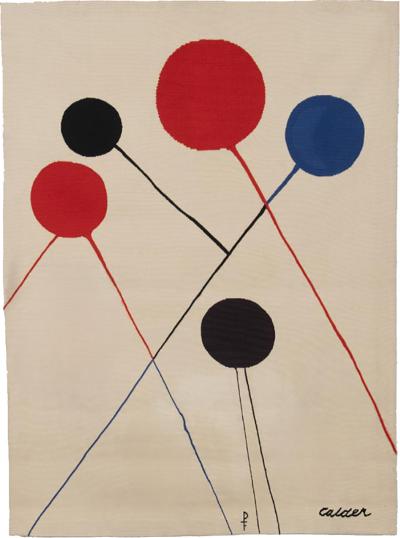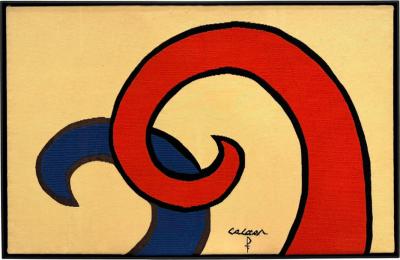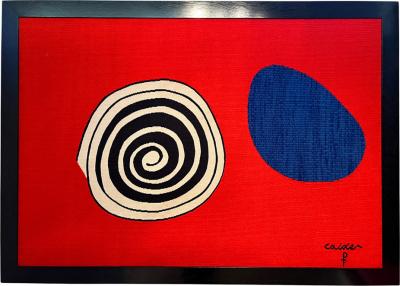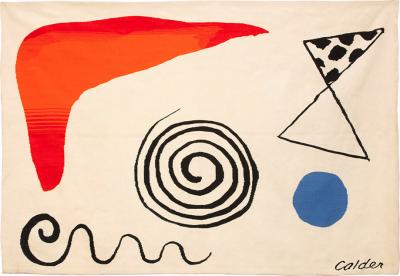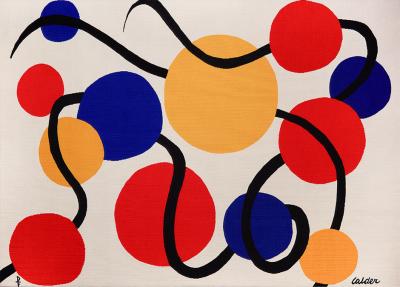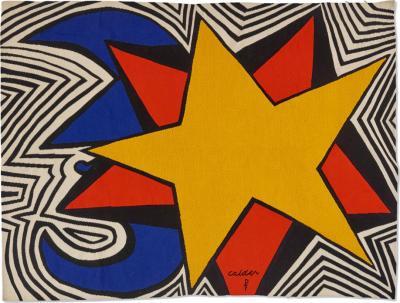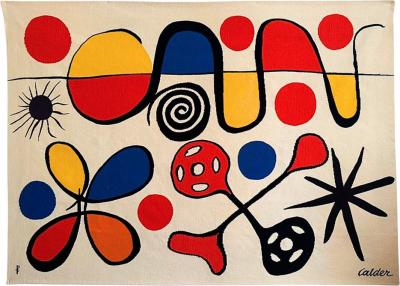Alexander Calder
American, 1898 - 1976
One of America's best known sculptors, Alexander Sandy Calder became most famous for his kinetic abstract sculpture which took two forms - standing object stabliles and hanging suspended mobiles. He also created floor pieces, was a painter in watercolor, oil and gouache, did etchings and serigraphs, made jewelry and tapestries as well as designing theater stage settings and architectural interiors.
He was born in Philadelphia, the son of Alexander Sterling Calder and the grandson of Alexander Milne Calder, well-known sculptors of public monumental works. His mother, Nanette Lederer Calder, was a professional portrait painter. From an early age, he was making figures from found objects. He was unable to make a decision about a vocation, but his fascination with machines led to his earning a degree in mechanical engineering from the Stevens Institute of Technology in 1919. In 1923, he began studies at the Art Students League in New York City, and worked as an illustrator for the National Police Gazette magazine. In 1925, he produced an illustrated book titled Animal Sketching, one-line drawings that foreshadowed his early wire sculptures of figures and animals. In 1926, encouraged by an engineer friend of his father to follow his talent, he went to Paris where he lived the next seven years and shortly after his arrival began creating wire sculptures. He assembled a "Circus," of miniature, hand activated one-wire figures with which he gave performances in his studio. These pieces were made by bending and twisting a single wire into humorous portraits, animals, and figure groups. He also met many of the leading avant-garde artists of the day including Piet Mondrian, who influenced Calder's geometric, non-objective constructions that he began producing in 1931. His floor pieces, named "stabiles" by Jean Arp, were exhibited in a gallery exhibition organized by Marcel Duchamp, who coined the word "mobile" for the hanging, kinetic pieces. Soon, Calder was creating many of these wind-driven works. Calder's mobiles were first shown in the United States in 1932, and the next year he returned to America and purchased a home in Roxbury, Connecticut where he lived the remainder of his life. Dancer Martha Graham used several of his sculptures in her modern dance performances, and personnel at the Museum of Modern Art in New York began purchasing pieces from him including his first large-scale piece called Whale in 1937. During World War II when metal was scarce, he made mobiles and stabiles from carved, painted wood, and in the early 1950s he added to his repertoire wall pieces and mobiles that incorporated sound. Many federal agencies and businesses commissioned works by him, and most major American museums have his pieces in their collections. In 1976, President Gerald Ford intended to award Calder with the Presidential Medal of Freedom. Calder declined the medal in protest against the administration's refusal to grant amnesty to Vietnam War draft resisters, in keeping with his lifetime support for pacifist causes. The award was bestowed posthumously the following year to Calder's widow.
Alexander Calder Artwork
He was born in Philadelphia, the son of Alexander Sterling Calder and the grandson of Alexander Milne Calder, well-known sculptors of public monumental works. His mother, Nanette Lederer Calder, was a professional portrait painter. From an early age, he was making figures from found objects. He was unable to make a decision about a vocation, but his fascination with machines led to his earning a degree in mechanical engineering from the Stevens Institute of Technology in 1919. In 1923, he began studies at the Art Students League in New York City, and worked as an illustrator for the National Police Gazette magazine. In 1925, he produced an illustrated book titled Animal Sketching, one-line drawings that foreshadowed his early wire sculptures of figures and animals. In 1926, encouraged by an engineer friend of his father to follow his talent, he went to Paris where he lived the next seven years and shortly after his arrival began creating wire sculptures. He assembled a "Circus," of miniature, hand activated one-wire figures with which he gave performances in his studio. These pieces were made by bending and twisting a single wire into humorous portraits, animals, and figure groups. He also met many of the leading avant-garde artists of the day including Piet Mondrian, who influenced Calder's geometric, non-objective constructions that he began producing in 1931. His floor pieces, named "stabiles" by Jean Arp, were exhibited in a gallery exhibition organized by Marcel Duchamp, who coined the word "mobile" for the hanging, kinetic pieces. Soon, Calder was creating many of these wind-driven works. Calder's mobiles were first shown in the United States in 1932, and the next year he returned to America and purchased a home in Roxbury, Connecticut where he lived the remainder of his life. Dancer Martha Graham used several of his sculptures in her modern dance performances, and personnel at the Museum of Modern Art in New York began purchasing pieces from him including his first large-scale piece called Whale in 1937. During World War II when metal was scarce, he made mobiles and stabiles from carved, painted wood, and in the early 1950s he added to his repertoire wall pieces and mobiles that incorporated sound. Many federal agencies and businesses commissioned works by him, and most major American museums have his pieces in their collections. In 1976, President Gerald Ford intended to award Calder with the Presidential Medal of Freedom. Calder declined the medal in protest against the administration's refusal to grant amnesty to Vietnam War draft resisters, in keeping with his lifetime support for pacifist causes. The award was bestowed posthumously the following year to Calder's widow.
Alexander Calder Artwork
Alexander Calder
Alexander Calder, "Spring Carnival" Authentic Lithograph, 1969
H 29 in W 36 in D 1 in
$ 1,600
